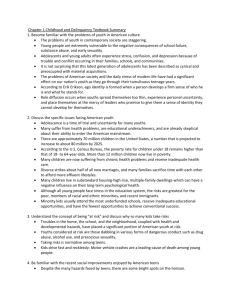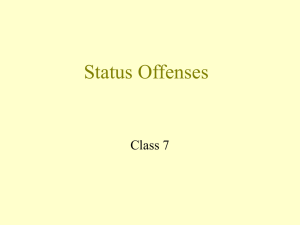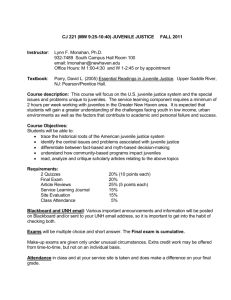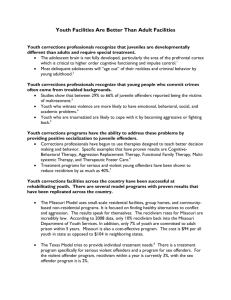sample file
advertisement
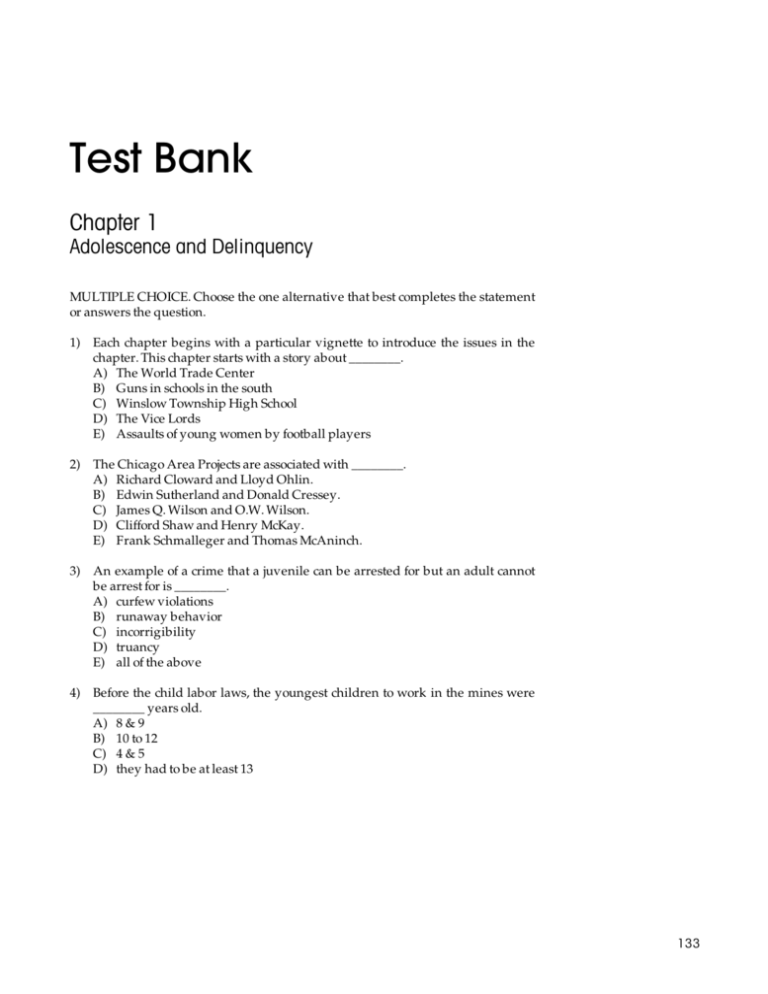
Test Bank Chapter 1 Adolescence and Delinquency MULTIPLE CHOICE. Choose the one alternative that best completes the statement or answers the question. 1) Each chapter begins with a particular vignette to introduce the issues in the chapter. This chapter starts with a story about ________. A) The World Trade Center B) Guns in schools in the south C) Winslow Township High School D) The Vice Lords E) Assaults of young women by football players 2) The Chicago Area Projects are associated with ________. A) Richard Cloward and Lloyd Ohlin. B) Edwin Sutherland and Donald Cressey. C) James Q. Wilson and O.W. Wilson. D) Clifford Shaw and Henry McKay. E) Frank Schmalleger and Thomas McAninch. 3) An example of a crime that a juvenile can be arrested for but an adult cannot be arrest for is ________. A) curfew violations B) runaway behavior C) incorrigibility D) truancy E) all of the above 4) Before the child labor laws, the youngest children to work in the mines were ________ years old. A) 8 & 9 B) 10 to 12 C) 4 & 5 D) they had to be at least 13 133 134 Test Bank 5) A Medieval English doctrine that sanctioned the right of the Crown to intervene in natural family relations whenever a child's welfare was threatened. The philosophy of the juvenile court is based on this legal concept. A) in loco parentis B) parens patriae C) The Power of the King D) The Divine Right of Kings E) none of the above 6) It was the influence of ________ that encouraged individualism and personal growth in the classroom. A) Sigmund Freud B) Herbert Hoover C) Franklin Roosevelt D) John Dewey E) Emile Durkheim 7) The term defining the life interval between childhood and adulthood is called ________. A) puberty B) adolescence C) delinquency D) socialization 8) By 1914, almost every state had passed laws prohibiting the industrial employment of children under the age of ________. A) 10 B) 16 C) 14 D) 12 9) Psychologist Eric Erickson observed that "childhood" is the model of all ________. A) development B) oppression and enslavement C) special attention D) guidance 10) Nanette J. Davis contends that much of the youth crisis today is ________. A) inflated B) arranged C) political D) invisible 11) John E. Donovan and Richard Jessor suggested the interrelationships among high-risk behaviors share a common factor of ________. A) tolerance B) drug use C) victimization D) unconventionality Test Bank 12) Travis Hirschi suggests a common factor underlying problem behaviors is ________. A) majority variance B) racial profiling C) lack of self-control D) inadequate juvenile justice 13) The legal term delinquency first originated in 1899 in the State of ________. A) Indiana B) Iowa C) Ohio D) Illinois 14) Actions or behaviors that would NOT be defined as criminal if adults committed them are called ________. A) misdemeanors B) uniform offenses C) petty offenses D) status offenses 15) The rehabilitative philosophy of the juvenile court is referred to as ________. A) tempus fugit B) duces tecum C) Certiorari D) parens patriae 16) Psychological testing of many status offenders has suggested they suffer from ________. A) depression B) post traumatic stress disorder C) multiple-personality disorder D) attention deficit disorder 17) Meda Chesney-Lind contends the juvenile justice system discriminates against girls, because society believes it must protect adolescent girls from consequences of ________. A) sexual desires B) social inequality C) power struggles D) victimization 18) According to data from a national study, which of the following identified groups were more likely to commit misdemeanors along with status offenses? A) heavies B) middleweights C) lightweights D) conforming youths 19) Most studies generally conclude that status offenders escalating to more serious behaviors is ________. A) proven to be true B) highly probable C) not likely D) proven to be false 135 136 Test Bank 20) The Deinstitutionalization of Status Offenders Project (DSO) ________. A) required that all juveniles be tried as juveniles and not adults B) separated status offenders from juvenile delinquents C) stopped the detention of African-Americans D) required that all juveniles receive probation 21) Which of the following states have decriminalized status offenders? A) Washington B) New York C) Maine D) All of the above 22) The colonists believed the primary source of social control of children was ________. A) religion B) police C) family D) school 23) The intent of the Supreme Court decisions of 1967-1975 was to ensure the children would have ________. A) jury trials B) supportive parents C) due process rights D) educational alternatives 24) In 1988 and 1989, what became a major impetus for the development and spread of drug-trafficking street gangs? A) crack epidemic B) decreasing murder rates C) deinstitutionalization D) America's war on drugs 25) In 1995, a criminal case involving Susan and Anthony Provenzano of St. Clair Shores, Michigan captured national attention to the growing trend of what type of laws? A) habitual offender B) drug C) domestic abuse D) parental responsibility 26) Allowing criminal and juvenile courts to impose either juvenile and/or adult sentences is referred to as what type of sentencing? A) indeterminate B) expanded C) graduated D) creative 27) The social context that examines the relationship between social institutions and delinquency is called ________. A) political B) historical C) sociocultural D) legal Test Bank 28) Studies that view delinquent behavior as being affected by a variety of forces on several levels is referred to as ________. A) contextual analysis B) poly analysis C) micro perspective D) process analysis 29) Which term refers to recognizing that juveniles are acted upon by social influences, structural constraints, and choices made available to them? A) contextual B) analytical C) human agency D) political 30) Life course theory contends one's cultural background such as location in time and ________ is an element of shaping a person's life course in delinquency. A) crime B) place C) theory D) mainstream TRUE/FALSE. Write 'T' if the statement is true and 'F' if the statement is false. 31) The lengthening of adolescence in U.S. culture has further increased youth crises and life struggles. 32) According to Bartollas, child labor laws had little impact of defining adolescence. 33) According to Eric Erickson, the lack of rights given to young people is a chief reason for repression. 34) Nanette Davis believes that America's social institutions have little impact on the youth crisis. 35) High-risk youth are more likely to experience multiple problem behaviors that will likely lead to socially undesirable behaviors. 36) Travis Hirschi believes that the relationship between drug abuse and delinquency are manifestations of one common factor, criminality. 37) The average delinquent today is far more likely to commit serious crimes, rather than petty crimes of theft. 38) Juvenile courts typically hear only delinquency cases, while social work agencies have jurisdiction over neglect cases. 39) Status offenders frequently come from single-parent homes and often times engage in verbal and physical abuse directed toward the parent(s). 40) Status offenders tend to resist authority and are frequently prescribed Ritalin to control hyperactivity. 137 138 Test Bank 41) Chesney-Lind argues that the juvenile justice system discriminates against girls. 42) A national study suggested that status offenders are more likely to be white than nonwhite. 43) According to Bartollas, most studies conclude that status offenders are NOT likely to progress into delinquency. 44) Status offenders are more prone to recidivism than are delinquent offenders. 45) Public whippings and dunking were common punishments for chronic offenders during the colonial period. 46) The use of training schools flourished during the late 1960s and early 1970s. 47) The main purpose of the reform agenda of the 1970s was to divert status offenses from a criminal to a noncriminal setting. 48) The use of curfew laws to control delinquent behavior decreased during the 1990s. 49) During the 1990s, repressive methods to control gang behaviors were far more typical than intervention strategies. 50) In the 1990s, several states actually decreased legislation efforts for prosecution of juveniles in adult court. SHORT ANSWER. Write the word or phrase that best completes each statement or answers the question. 51) ________ of early childhood fester into socially unacceptable behavior in later years. 52) Youth in crisis are involved in ________ arrangements such as discrimination and humiliation of racism, deprivations of poverty, the culture of violence, and the ever-present temptation of drugs and alcohol. 53) Of the twenty-five million adolescents in the United States, approximately one in four is at ________ for engaging in multiple problem behaviors. 54) An institution that was designed by 18th and 19th century reformers to provide an orderly, disciplined environment similar to that of the ideal Puritan family was called a ________. 55) According to Meda Chesney-Lind, a ________ exists between male and female adolescents. 56) The 1974 Juvenile Justice and Delinquency Prevention Act served as an impetus for ________ of status offenders. Test Bank 57) Juvenile courts can institutionalize status offenders by simply ________ them as delinquent. 58) The period of 1824-1898 is known as the ________ period in which reformers became disillusioned with family control of delinquents. 59) The medieval English doctrine that sanctions the right of the crown to intervene in family relations is termed ________. 60) Glen H. Elder and associates have done much to stimulate the use of ________ theory as an appropriate research base in the study of individuals and groups associated with juvenile delinquency. 61) The life interval between childhood and adulthood; usually the period between the ages of twelve and eighteen years is called ________. 62) A project that evaluates the effects of deinstitutionalization of status offenders in eight states and prompted a national evaluation is called the ________. 63) Institutions that were designed by eighteenth and nineteenth century reformers to provide an orderly disciplined environment similar to the "ideal" Puritan family is called ________. 64) An act committed by a minor that violates the penal code of the government with the authority over the area in which the act occurs is called ________. 65) A federal law that established a juvenile justice office within the Law Enforcement Assistance Administration to provide funds for the prevention and control of youth crime was called the ________. 66) A sociological framework suggesting that four key factors determine the shape of the life course: location in time and place, linked lives, human agency, and timing of lives is called the ________. 67) A Medieval English doctrine that sanctioned the right of the Crown to intervene in natural family relations whenever a child's welfare was threatened was called ________. The philosophy of the juvenile court is based on this legal concept. 68) A juvenile who commits a minor act that is considered illegal only because he or she is underage is called a ________. 69) Offenses like curfew violations, incorrigibility, running away, truancy, and underage drinking are called ________. 139 140 Test Bank ESSAY. Write your answer in the space provided or on a separate sheet of paper. 70) Describe how the adolescence period in America is affected by various social factors related to our culture. 71) Discuss the three categories of juvenile behavior in which the juvenile court has jurisdiction. 72) Describe the affects that the Deinstitutionalization of Status Offenders Project (DSO) had on status offenders. 73) What are the four key elements of the life-course paragigm? Explain each. 74) Define the elements of a "social context" focus as described by Bartollas. Test Bank Answer Key Chapter 1 1) C 25) D 49) TRUE 2) D 26) B 50) FALSE 3) E 27) C 51) Unmet needs 4) C 28) A 52) structural 5) B 29) C 53) high risk 6) D 30) B 54) house of refuge 7) B 31) TRUE 55) double standard 8) C 32) FALSE 56) deinstitutionalization 9) B 33) TRUE 57) redefining 10) D 34) FALSE 58) house of refuge 11) D 35) TRUE 59) parens patriae 12) C 36) TRUE 60) life-course 13) D 37) FALSE 61) adolescence 14) D 38) FALSE 62) Deinstitutionalization of Status Offenders Project (DSO) 15) D 39) TRUE 16) D 40) TRUE 17) A 41) TRUE 18) C 42) TRUE 19) C 43) TRUE 20) B 44) FALSE 21) D 45) TRUE 22) C 46) FALSE 23) C 47) TRUE 24) A 48) FALSE 63) houses of refuge 64) juvenile delinquency 65) Juvenile Justice and Delinquency Prevention Act of 1974 66) life course perspective 67) parens patriae 68) status offender 69) status offense 70–74) Answers will vary 257
